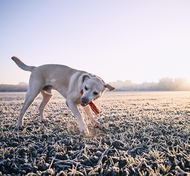Dog days of Summer - Help your dog beat the heat! - Bully Sticks Direct
Posted by Yeller Dog on Aug 07, 2020
People usually prepare themselves for the dangers of increased temperatures. But as the dog days of summer approach, our trusted companions also need special attention to insure that they don’t get burned. Like for us, the summer months bring an increased danger of heat exhaustion and heat stroke for dogs.
People naturally regulate their body temperature by sweating. Dogs mainly cool themselves by panting — breathing in through the nose and out through the mouth. The process of panting directs air over the mucous membranes (moist surface) of the tongue, throat and trachea (windpipe). The air that is flowing over these organs causes evaporation, thus cooling the nimal. Another mechanism that helps remove heat includes dilation of blood vessels in the skin of the face, ears and feet. Dilated blood vessels located on the surface of the body cause the blood to loose heat to the outside air.
A dog’s normal body temperature is 100.5 to 102.5 degrees Fahrenheit. Like people, dogs can become overheated. If it rises to 105 or 106 degrees, the dog is at risk for developing heat exhaustion. If the body temperature rises to 107 degrees, the dog has entered the dangerous zone of heat stroke. With heat stroke, damage to the body can be irreversible. Organs begin to shut down, and veterinary care is immediately needed.
Fortunately, if owners recognize heat exhaustion, they can prevent the dog from entering heat stroke. People can easily recognize when the heat gets to them because they become lightheaded and fail to sweat. For dogs, early signs of heat exhaustion may include failure to salivate and a dry mouth. Heat exhaustion may also include a dog lying down and looking tired, losing its appetite, and becoming unresponsive to owners.
While these steps may help a dog, the best treatment is prevention. In order to prevent overheating, some owners may shave their dogs or trim their fur excessively. This isn’t always a good idea. The hair coat may appear to be a burden for a dog; however, it can also keep the animal comfortable by trapping cool air next to the skin, reducing the amount of heat transferred from the hot outside air to the body of the dog.
If heat exhaustion progresses into heat stroke, the dog becomes very warm to touch and may have seizures. Internal mechanisms roll into effect that may cause blood clotting and organ damage. If you are near a phone and think that heat stroke is a possibility, call your local Animal Hospital immediately. If a veterinarian is not within reach, or while waiting for a veterinarian, get the dog out of the sun and cool him (her) down with cool water baths (cool – not cold). Provide a fan, especially if you wet the dog down, and encourage him (her) to drink water.
Dogs with long or thick coats that have problems with matted hair are often good candidates for clipping. Matted hair can cause skin irritation and is undesirable. Owners that do not have time to adequately remove mats and debris from their dog’s coat may prefer to have the coat clipped short. After a short clipping, and if the dog is outdoors, owners need to be careful of sunburn. Sunscreen may be applied to the dog’s skin; however, it is necessary to consult a veterinarian to find out which ones are safe.
Here are some other tips for keeping your dog cool this summer:
- Keep dogs indoors, in air conditioning.
- Do not leave dogs in a car during the summer. Even with the windows down, temperatures inside a car can quickly rise to above 120 degrees.
- Make sure outdoor dogs have plenty of shade.
- Keep fresh water available for dogs at all times.
- Exercise dogs early in the morning or late in the evening. If this is not possible, exercise in an air-conditioned environment. On very warm days, provide your dog with a sprinkler or wading pool.
- If you take the dog to a lake, make sure it has plenty of time to drink and get wet. Most dogs can drink lake water without adverse effects.
- If the dog has a light coat or exposed skin, take precautions against sunburn.
- Dogs can acclimate to warm temperatures and have no trouble staying outdoors in the heat. However, dogs that are used to cool climates or air conditioning should not be placed outside on warm days. Acclimating the dog gradually is the key.



